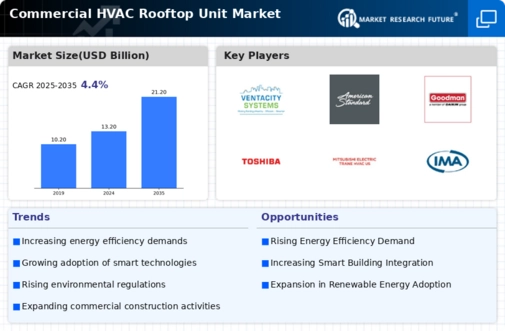Regulatory Pressures and Compliance
Regulatory pressures regarding energy efficiency and emissions are driving changes in the Commercial HVAC Rooftop Unit Market. Governments worldwide are implementing stricter regulations aimed at reducing greenhouse gas emissions and improving indoor air quality. Compliance with these regulations often necessitates the adoption of more efficient HVAC systems. For instance, the implementation of standards such as ASHRAE 90.1 has led to increased demand for rooftop units that meet or exceed these requirements. As businesses seek to avoid penalties and enhance their sustainability profiles, the market for compliant HVAC solutions is likely to see substantial growth. This regulatory landscape is shaping the future of the Commercial HVAC Rooftop Unit Market.
Rising Demand for Energy Efficiency
The increasing emphasis on energy efficiency is a primary driver for the Commercial HVAC Rooftop Unit Market. Businesses are increasingly seeking solutions that not only reduce operational costs but also align with sustainability goals. According to recent data, energy-efficient HVAC systems can reduce energy consumption by up to 30 percent. This trend is further fueled by government incentives and rebates aimed at promoting energy-efficient technologies. As organizations strive to minimize their carbon footprint, the demand for advanced rooftop units that offer superior energy performance is likely to grow. Consequently, manufacturers are innovating to meet these demands, leading to a more competitive landscape within the Commercial HVAC Rooftop Unit Market.
Increased Focus on Indoor Air Quality
The heightened awareness of indoor air quality (IAQ) is emerging as a significant driver in the Commercial HVAC Rooftop Unit Market. Businesses are recognizing the importance of providing a healthy indoor environment for employees and customers. This focus has led to an increased demand for HVAC systems that incorporate advanced filtration and ventilation technologies. According to studies, improved IAQ can enhance productivity and reduce absenteeism, making it a priority for many organizations. As a result, manufacturers are innovating to develop rooftop units that not only meet temperature control needs but also ensure superior air quality. This trend is likely to propel growth within the Commercial HVAC Rooftop Unit Market.
Technological Advancements in HVAC Systems
Technological advancements play a crucial role in shaping the Commercial HVAC Rooftop Unit Market. The integration of smart technologies, such as IoT and AI, enhances system performance and operational efficiency. These innovations allow for real-time monitoring and predictive maintenance, which can significantly reduce downtime and repair costs. Furthermore, the market is witnessing the introduction of variable refrigerant flow systems that provide better temperature control and energy savings. As businesses increasingly adopt these advanced systems, the overall market is expected to expand. The ability to leverage data analytics for optimizing HVAC operations is likely to drive further growth in the Commercial HVAC Rooftop Unit Market.
Expansion of Commercial Construction Activities
The expansion of commercial construction activities is a vital driver for the Commercial HVAC Rooftop Unit Market. As new commercial buildings are constructed, there is a growing need for efficient HVAC systems to support these developments. The construction sector is experiencing a resurgence, with investments in office spaces, retail establishments, and industrial facilities on the rise. This trend is expected to continue, leading to increased demand for rooftop units that can cater to the specific needs of modern buildings. Additionally, the trend towards retrofitting older buildings with new HVAC systems further contributes to market growth. As such, the Commercial HVAC Rooftop Unit Market is poised for expansion in response to these construction trends.






















Leave a Comment